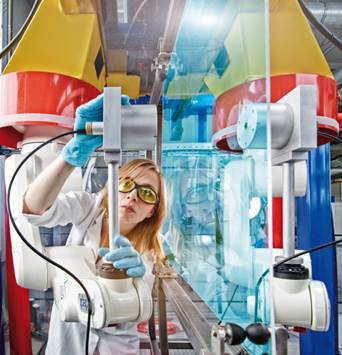Noncontact and contamination-free materials inspection – hybrid materials easily tested

Air-coupled ultrasound: An industrial robot linked to an ultrasound inspection system scans the component. Copyright: Uwe Bellhäuser
From 10 to 12 March 2015, at the JEC Europe in Paris, engineers of Fraunhofer IZFP in Saarbrücken will introduce a novel procedure which enables noncontact and contamination-free defect inspection even in case of strongly absorbing hybrid materials (hall 7.2, booth F35).
They are not ascertainable by the naked eye – nevertheless minute cracks or defects, particularly in safety-critical sectors, can cause disastrous consequences. Notwithstanding this the requests for weight reduction without materials impairment steadily increase.
In order to meet such requirement profiles, the use of new materials – such as carbon or glass fiber-reinforced plastics (CFRP, GFRP), high-strength steels and light metals, often also in combination for hybrids applications – is indispensable.
Researchers at Fraunhofer Institute for Nondestructive Testing IZFP in Saarbrücken succeeded in enhancing the use of air-coupled ultrasound as a nondestructive inspection method for noncontact and contamination-free materials inspection. “The probes we developed at our institute to examine thin materials allow higher frequency compared to competing products. Due to this improvement a highly sensitive and optimized defect detection capability is achieved,” Dr. Thomas Waschkies, responsible engineer at Fraunhofer IZFP, explains.
“The improved probe design with its higher noise allows the contamination-free examination even of strongly absorbing hybrid materials.” In particular the lower inspection frequencies are important for the examination of these materials – which in general can´t be examined in immersion technique – since at lower frequencies the attenuation of sound in the material is much lower than in case of conventional testing.
Each inspection application comes with its specific requirements concerning accessibility, defect resolution, robustness against environmental influences and special probe type. That’s why Fraunhofer IZFP’s air-coupled ultrasound transducers are custom-made for a particular application.
“The air-coupled ultrasound inspection is particularly suitable for the examination of thin plates with thicknesses of some few centimeters. However, in principle all materials currently used in modern structural components, e. g., in automotive industry or aircraft, can be examined,” Waschkies says. Often, these so-called ‘new materials’, such as CFRP, GFRP, high strength steels and light metals, are combined and processed to hybrid components or parts.
At this year's JEC Europe in Paris, beside of demonstrating and explaining the principle functionality of this inspection method, Fraunhofer IZFP will give indications for applications in many industrial sectors.
Media Contact
All latest news from the category: Trade Fair News
Newest articles

First-of-its-kind study uses remote sensing to monitor plastic debris in rivers and lakes
Remote sensing creates a cost-effective solution to monitoring plastic pollution. A first-of-its-kind study from researchers at the University of Minnesota Twin Cities shows how remote sensing can help monitor and…

Laser-based artificial neuron mimics nerve cell functions at lightning speed
With a processing speed a billion times faster than nature, chip-based laser neuron could help advance AI tasks such as pattern recognition and sequence prediction. Researchers have developed a laser-based…

Optimising the processing of plastic waste
Just one look in the yellow bin reveals a colourful jumble of different types of plastic. However, the purer and more uniform plastic waste is, the easier it is to…



